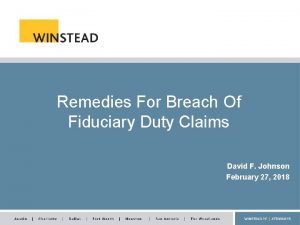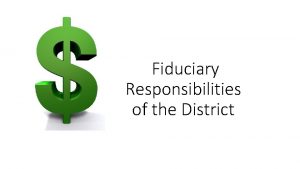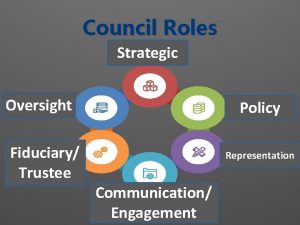Fiduciary Duties The term fiduciary comes from the







- Slides: 7

Fiduciary Duties • The term “fiduciary” comes from the Latin “fiducia” which means “trust” • Committees have fiduciary duties that can be divided into the following categories: 1. Duty of loyalty – the obligation to act for the exclusive benefit of the plan participants and beneficiaries 2. Duty of care – the responsibility to administer the plan as a “prudent man” and to have competency to give fiduciary advice. 3. Duty to disclose – all material facts and all conflicts of interest 4. Duty to diagnose – know your customer and investigate the suitability 5. Duty to consult – work with individuals who have specialized knowledge in the field 6. Duty to keep current – keep current with regulatory developments and market environment 1

What Makes You a fiduciary? § Plan stewards have ultimate responsibility for ensuring a plan is properly managed § You are a “named” fiduciary § You exercise discretion over the plan § You have the authority to appoint other fiduciaries § You are “functional” fiduciary Functional Fiduciary: Individual who unknowingly makes a fiduciary decision 2

What are 457(b) fiduciary decisions ? § Reviewing your plan(s) and benchmarking fees § Selecting the number of vendors in your plan § Selecting and the investment options in your plan (not vendor) § Monitoring the investment options in your plan (not vendor) § Removing the investment options in your plan (not vendor) § Monitoring the effectiveness of your service providers § Minimizing plan costs to a “reasonable level” § Evaluating the share classes of each fund on each option 3

If investment fees are one percentage point higher than a reasonable amount, the participant’s retirement account will be 28 percent lower after a 35 year career. - U. S. Department of Labor 4

Summary of Industry “Best Practices” 1. Investment Policy Statement (“IPS”) - Build an IPS to provide specific guidelines and directions for the plan. This document will serve as evidence that there is a written decision making process in place. It should be reviewed at least annually. 2. Provider Search (Putting the plan out to bid) – A competitive bid process is a highly effective tool for negotiating fees and services with a new and/or current provider. In most cases, plans experience enhancements to their program features and/or pricing as a result of this process – particularly when the plan’s asset size has increased. A provider search should be conducted every 5 to 7 years. 3. Target Date Fund Suitability Study – Conduct a suitability study to determine the most appropriate TDF series for plan participants. This study will consider the glide path*, underlying asset allocation, risk profile and performance of various target date fund series. This study should be conducted once every three years. *A target date fund represents a planned progression of asset allocation changes over time. This progression is know as the “glidepath”. The glidepath becomes more conservative over time, investing more in fixed income and less in equities as retirement approaches. 5

Summary of Industry “Best Practices” 4. Share class review – Perform an annual review of all the available share classes to ensure the most cost effective shares are being utilized. 5. Monitoring the investment options – A periodic review of the investment lineup should be conducted. Areas of focus include performance (against benchmarks and peers) and investment fees. 6. Review fee policy – Examine the fees associated with the plan and understand how all plan providers are paid. The fee structure should be reviewed on an annual basis. (e. g. flat fee vs asset based fee, revenue sharing vs. explicit fee) 7. Conducting a fee benchmarking study - Current plan fees should be benchmarked against other leading service providers. This helps ensure that current fees are inline with the market place. Fees should be benchmarked once every three years. 6

Ungoverned plans are plagued by: 1. A large number of vendors 2. High program fees 3. Above average investment management fees (especially on passive options) 4. Large number of investment options 5. Lack of fee transparency 6. Fee inequity – fees varies based upon the fund that is selected 7. Options are selected by the vendor 8. Closed architecture (large number of vendor’s own proprietary funds) 9. Potential surrender charges 10. No portability at plan level 11. Commissioned agents 12. Vendorsed educational programs 7












